CULINARY
creations
Global Pasta
The next wave of pasta products boasts a world’s worth of influences and a host of new nutritional benefits, all introduced through ingredients novel to noodles and largely nonexistent in the pasta and prepared pasta meal spaces. Exploring beyond Italian and Asian, product developers have turned to cuisine cultures ranging from Eastern Europe to Turkey to North Africa to bring greater variety—and nutrition—to the humble noodle dish.
When exploring the varieties of pasta preparations found in countries off the well-trodden culinary path, the first aspect to notice is the variety of grains, seeds, legumes, and even vegetable flours used in crafting noodles. For example, the North African koshari, a dish popular in Egypt made with wheat pasta, rice, and lentils seasoned with garlic, fried onions, and, in some cases, a small amount of tomato and herbs.
Turkey has a rich pasta culture largely unexplored in the West. However, mantu, a filled pasta packet similar to a more loosely folded Chinese dumpling, is one of the most popular comfort foods in Anatolian cuisine. Thin sheets of pasta are cut into small pieces, filled with meat, lentils or other regional fillings, then sealed and either boiled or fried in oil. They’re traditionally served hot with garlic yogurt and tomato sauce or butter and red pepper flakes.
By ANNE-MARIE RAMO, Contributing Culinary Editor
Photo courtesy of: Bertolli/ConAgra Brands, Inc.
Pasta’s next great leap includes new global horizons and greater nutrition.
Mushroom for improvement
While mushrooms typically have been married to pasta via a sauce or filling, a recent study found that mushroom powder can improve the quality and texture of pasta. The study specifically studied the effects of fractions of the healthful polysaccharide beta-glucan in mushroom powder on the sensory attributes of wheat pasta. Results revealed that the mushroom powder not only increased the dietary fiber content of the pasta, it also helped improve the dough’s stability and decreased product degradation.
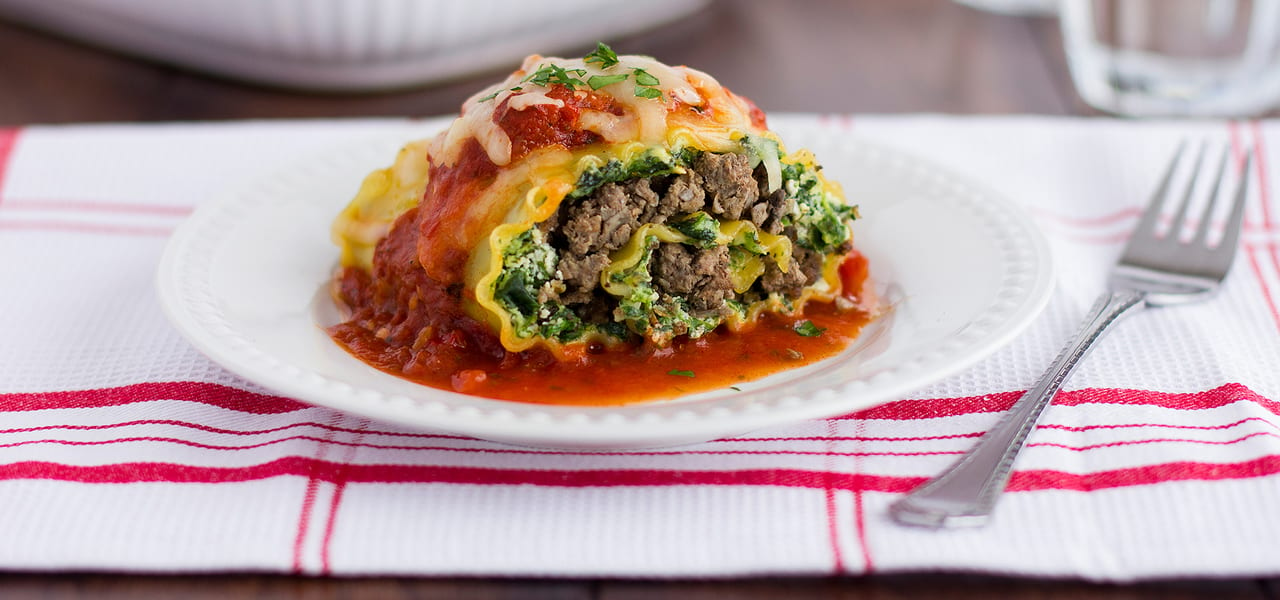
Photo courtesy of: The Mushroom Council
A recently popular noodle dish is kugel, a sweet noodle dish that is moving outside of its Lithuanian/Polish/Russian Jewish roots into the mainstream. Made of egg noodles flavored with cinnamon and fruit (most often raisins or chopped apples), it’s prepared casserole-style and served warm or cold, cut into squares.
Beyond wheat and rice
The modern “better for you” movement can be said to have begun with the promotion of whole grains and the benefits of fiber. This also brought pasta back into the good graces of consumers focused on healthier eating. Today, “whole grain” on a pasta package may indicate more than just wheat flour inside, with pasta products including all manner of sources for flour.
Whole-grain versions of wheat, corn, and rice are still employed, but pasta made from ancient wheat forms, such as spelt, farro (emmer), and kamut, as well as from seeds such as chia, quinoa, flax, sorghum, amaranth, teff, and millet are becoming mainstream.
Sorghum is a grain experiencing an upsurge in popularity and adding whole-grain sorghum flour to pasta significantly increases the dietary fiber content. Sorghum flour has a relatively neutral flavor and its natural cream color makes it an almost undetectable replacement for semolina in noodle formulas. Noodles made with a high level of sorghum, however, do require binders such as cornstarch or xanthan gum to ensure flexibility inthe product.
Chia and flax pack a powerful nutritional punch, contributing high levels of fiber, antioxidants, and omega-3 fatty acids. Developers able to include 1.3 g of these whole-seed flours per product serving may claim the pastas as an "excellent source" of ALA omega-3. These pastas also are high in soluble fiber, which provides structure, balances moisture, and mitigates staling during storage.
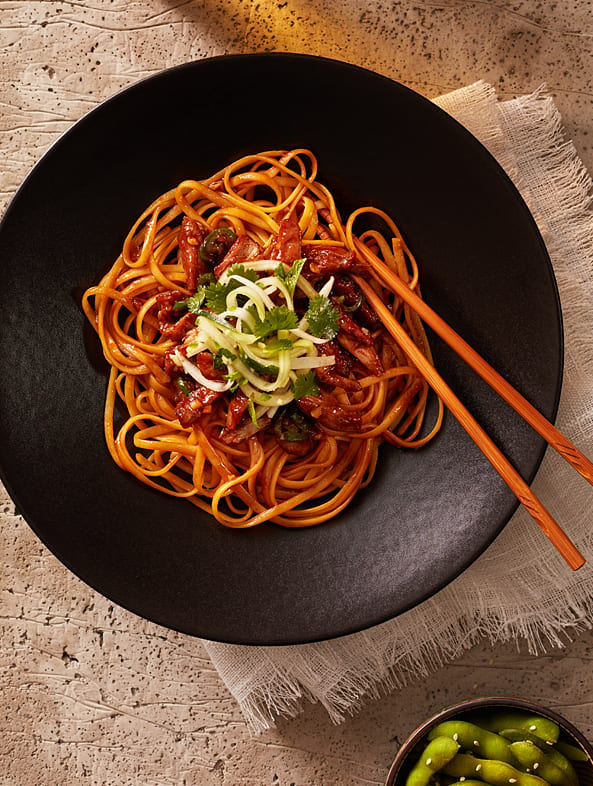
Pasta is expanding its borders across continents and cultures and even makers of traditional formats are helping widen the noodle horizons. Photo courtesy of: Barilla America, Inc.
Pasta Tech
Keeping in step with ingredient innovation, pasta manufacturers are experimenting with pasta shapes as well. Enter the 3D printer. With a 3D printer, a pasta maker can extrude dough in intricate patterns limited only by imagination and gravity.
Still in its prototype phase, the 3D printer uses a pasta shape designed via a computer-aided-design (CAD) program. Then, cartridges are filled with dough and loaded into the printer, replicating the design by creating concentric lines that result in the finished shape.
Pasta can be a logistical puzzle for manufacturers. For example, most pasta shapes need large boxes to transport them without causing damage to the product, and then there's the plastic used in this type of packaging, which ends up in a landfill, or even worse, the oceans. Seeking to solve this issue, a team at the Morphing Matter Lab at Carnegie Mellon University has discovered a sustainable solution: flat-packed pasta.
To create the easily transportable pasta, the team introduced surface grooves to the flat pasta dough that “tune” a differential swelling rate of the pasta as it cooks in order to form shapes from the flat dough. By designing the groove patterns in various ways, they can manipulate the shape of the resulting cooked pasta. The best part is that the researchers suggest that existing manufacturing processes such as stamping, laser etching, and casting can create the grooves, making adoption a viable adoption for some pasta manufacturers.
Many of these pasta varieties cook to a preferred al denté texture and deliver a slightly robust, even nutty flavor. Although some can have very slight bitter flavor notes on their own, they tend not to require any masking flavors when used for packaged meals.
Against the grain
Noodles from legumes have not only grown in popularity but spare no bean or pea. It’s easy to find pastas made from flours and starches derived from peas, soybeans, chickpeas, mung beans, black beans, or fava beans. In fact, Pasta giant Barilla America, Inc., recently announced it is expanding its legume pasta line with a new chickpea spaghetti pasta made from just one single ingredient, chickpea flour. Such pasta products also are a big plus for gluten-free formulations.
Some legume and pulse flours can carry “beany” flavors that might not work as well in an ingredient like pasta, which typically has a neutral flavor. Fortunately, ingredient manufacturers have answered this need with legume flours processed in such a way as to reduce this flavor (along with the distinctive color some beans and legumes have), creating noodle products with a flavor closer to that of classic semolina noodles.
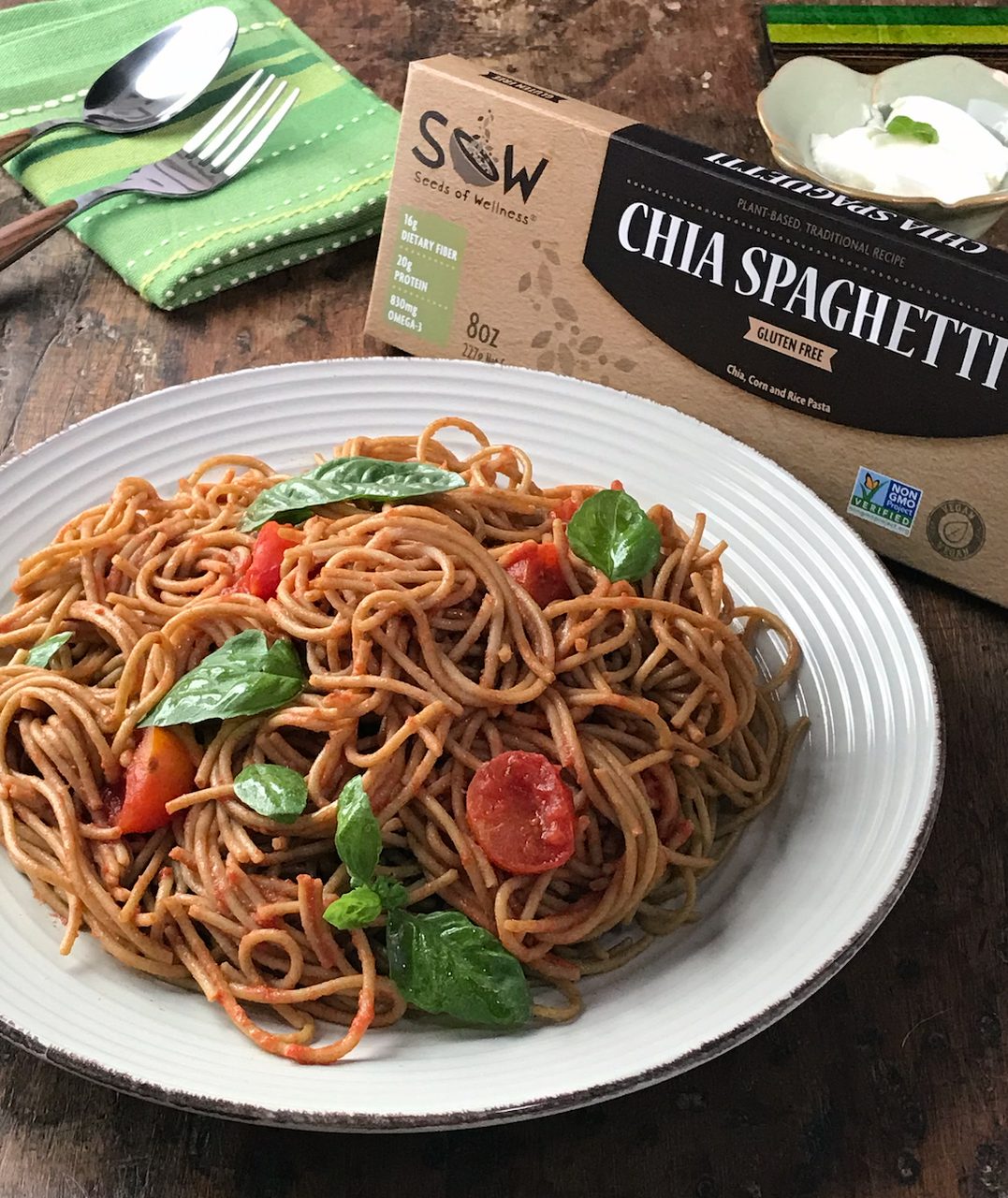
Flours from nutritious seeds seed like chia contribute impressive nutritional benefits such as fiber, protein, and healthful fats. Photo courtesy of: Seeds of Wellness/Functional Products Trading SA
Nuts for pasta
Peanuts are on the horizon as a healthful booster for pasta. Researchers at the University of Georgia determined that replacing from 35% to 45% of wheat flour with peanut flour, while adding 2.4% to 2.9% carrageenan by weight increased the protein content of the pasta while improving dough viscosity and firmness.
Pastas made with legumes and pulses have a mild nutty flavor and a firm texture, retained through even rigorous cooking methods. This resiliency makes them ideal for frozen or refrigerated meals as well as retort products.
Research chefs have produced pastas that take such noodles and use them in familiar ways to recreate familiar dishes or, in some cases, adhere to the traditions of the countries the pasta came from. For formulators looking to find a pasta product closer in flavor to a traditional semolina pasta than a whole wheat product, quinoa pasta may offer a viable solution.
Going green…and red and orange
Chefs have been adding spinach, carrot, tomato, and beet powders to pasta dough for decades, typically to add a bright color. However, new pasta producers are creating vegetable-based noodles that offers more than just visual vibrancy to a dish.
Pasta based on “flours” made from artichoke, kale, broccoli, pumpkin, butternut squash, sweet potato, cauliflower, and parsnips have hit the market in recent years. They typically are marketed for their nutritional value, gluten-free designation, or non-GMO status—or all three.
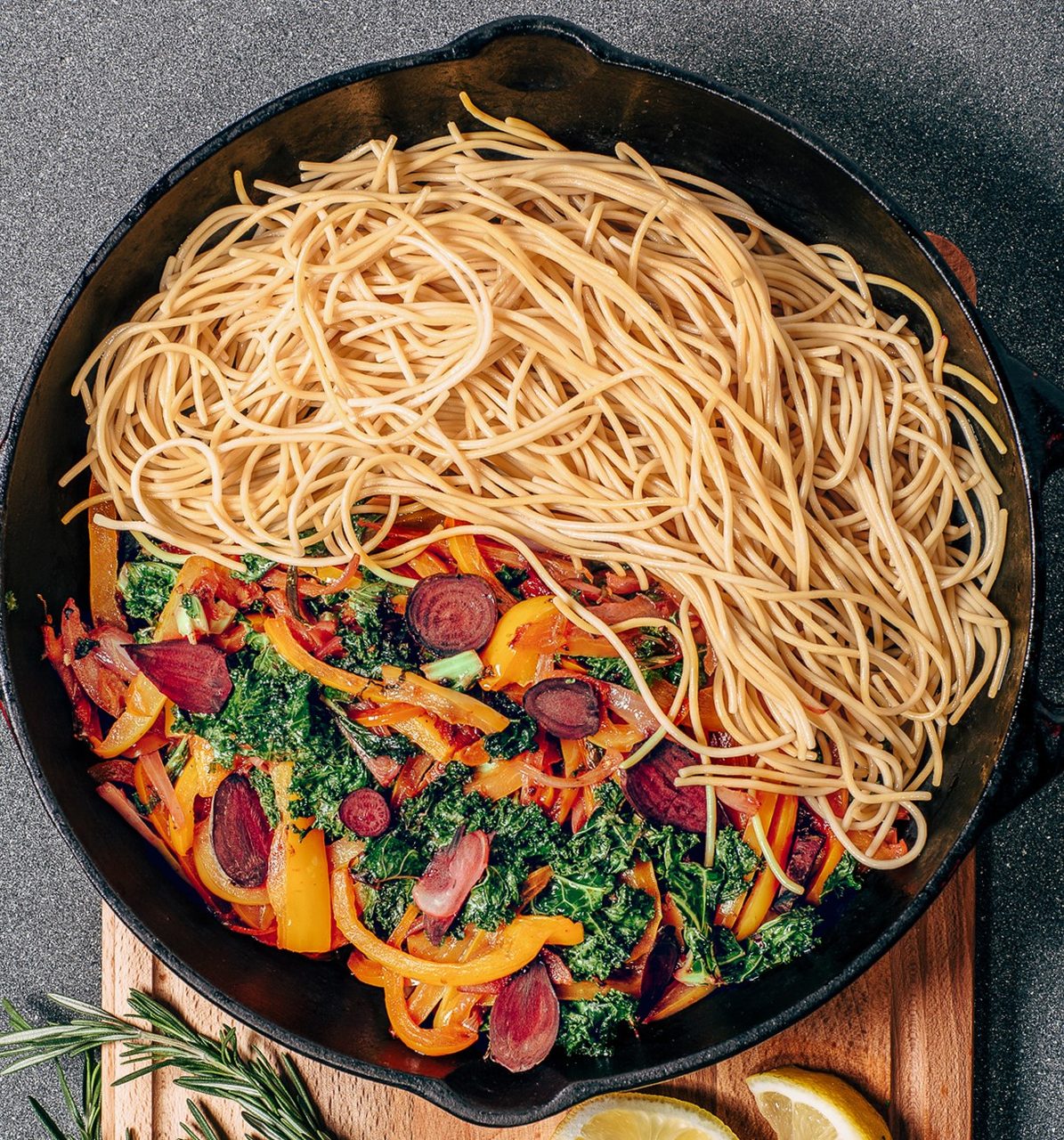
Pasta made from legumes such as chickpeas, have been trending up based on their non-GMO, gluten-free, and low glycemic status. Photo courtesy of: Banza, LLC
Cauliflower pasta is currently the most prevalent of the vegetable-based noodles. Riding on its success in pizza dough formulations, cauliflower flour is attractive because it has a high waste index (its ratio of edible to non-edible bits) and is nutrient-rich.
Cauliflower increases the dietary fiber content of pasta by some 48%, while also raising the levels of B vitamins and minerals (especially potassium and phosphorus). An added advantage is the addition of phytochemicals lauded for their ability to guard against cancer, cardiovascular disease, and diabetes.
New Old-World flavors
With the boom in interest in South Asian cuisine, Indian street food favorites need not be limited to curries and biryani rice dishes. There’s a solid place for Indian pasta dishes, such as masala pasta, a pasta dish combining short noodles with onion, ginger, garlic, tomatoes, green peas, carrot, and bell pepper in a cream based sauce spiked with red chili peppers, coriander, garam masala, fenugreek, and oregano. Or, perhaps a vegetable hakka, a dish made with a string noodle, and julienne vegetables, dressed with ginger, garlic, and chili peppers.

The growing popularity of North African and Near- and Middle Eastern cuisines introduced new dishes to the West, such as Egyptian koshari. Photo courtesy of: Basma/WikiCommons
In addition to the above-mentiond North African pastas, an up-and-coming entry is Libyans makaruna imbaukha. It’s a steamed pasta combined with meat, butter, tomatoes, onions, chickpeas, potatoes, pumpkin, and raisins. It’s well-seasoned with cloves, bay leaves, ginger, black pepper, and shaiba leaves). Also appearing on the current culinary scene is pasta saltata, featuring penne, potatoes, garlic, and onions, seasoned with harissa, lemon juice, arugula, and basil.
Translated into RTE and RTC meals, these dishes and others like them are poised to bring new excitement to the prepared pasta meal category. Developers have a world of pasta traditions to draw from in taking noodles to the next level. PF
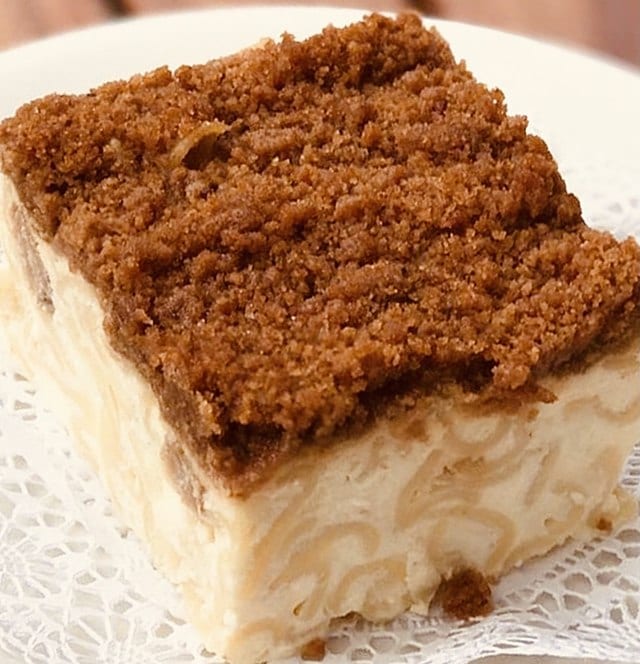
Yes, dessert pastas are a "thing," with classics such as Eastern European Jewish noodle kugel and Greek kataifi. Photo courtesy of: etonmessisthebest / Wikicommons
Regular contributor Anne-marie Ramo is a Seattle-based research chef and food writer with more than 25 years of experience in flavor development. She was director of culinary development for Revolution Foods Inc., executive chef of Fork in the Road Foods, LLC, and executive chef for Aidell’s Sausage Co. Read more of her articles at www.preparedfoods.com. You may contact her at aramo@me.com.
October 2021
